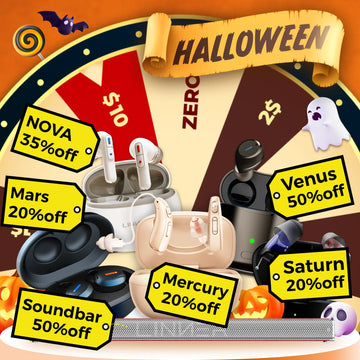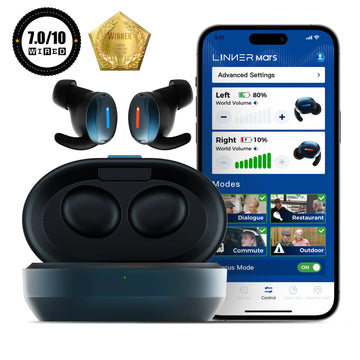Earwax (cerumen) is a normal, healthy substance that insulates your ear and protects it from dust, bacteria, and other debris. When you have excessive buildup of ear wax, it can cause discomfort, muffled hearing, tinnitus, or even lead to an ear infection. Your ears are designed to self-clean. Ear wax serves an important purpose, but ear canals can be too narrow to use this defense mechanism, long-term use of earbuds, and you are daily cleaning, often excessively with Q-tips, which can lead to blocked ear canals from ear wax.
Ear wax removal kits are designed for consumers to use at home, while providing varying safe alternatives that include irrigation (to wash out ear wax), ear wax softening drops, or even cameras to help navigate through accumulations of ear wax without damaging your ears.
This article will disclose our recommendations of 5 ear wax removal systems, allowing you to determine which system works best for you.
Best Ear Wax Removal Kits for 2025
Excessive ear wax can lead to discomfort, muffled hearing or even infection. We fully acknowledge how much better using the best ear wax removal kit will make you feel, the difference is night and day when it comes to ear hygiene. If you are a tech person wanting to head down the tech path, a minimalist wanting a simple, manual kit that gets the job done, or you want a clinical grade solution: the kits we reviewed, from 2025, that we found in our opinion, had options that were safe, effective and easy to use.
Using customer reviews, medical recommendations, and our testing methods, we were able to provide recommendations. From the fine cleaning methods or camera-assisted methods, to the gentle and basic cleaning irrigation systems, here are our favourite ear wax removal kits for your use, and systems that allow you to assist in ear cleaning and help maintain your ear hygiene.
1. Linnerlife Ear Wax Removal Kit
Specifications:
● 1080P HD Camera: This waterproof state of the art, detachable camera offers stream, ultra clear, real time video to your phone via the Linnerlife App. The wide-angle lens captures all sections of the ear canal to easily identify and target stubborn wax.
● Safety Guard: A flexible silicone earpiece enforces a threshold so the device does not penetrate too far into the ear canal, and minimizes injury risks.
● Variety of Tips: Use soft silicone scoops (gentle wax removal) or spiral attachments (harder buildup). All tips are sterilizable and hypoallergenic.
Pros:
● Visual Accuracy: Great for new users or people who want to see exactly what they are removing. The app also allows you to save videos for later.
● Travel-friendly: Compact, rechargeable, and uses USB-C, making it suitable for travelers.
● Waterproof: Easy to clean after use.
Cons:
● Expensive: Costs around $60-80, compared with non-camera kits.
● Connection Dependance: Requires a steady connection to a smart-device.
Why We Recommend It: The Linnerlife Earwax Removal Kit combines technology and functionality, and gives a modern way to remove earwax without having to guess. It’s cautiously user-friendly camera quality and flexibility help it stand out as an option for a tech-savvy adult or family who wants a safe, reusable, and clean option.

2. Bebird Earwax Removal Kit
Features:
● 4K Camera - Records in ultra-sharp definition (3840x2160 pixels). Outshines most brands. The autofocus immediately adjusts to the shape of the ear canal.
● Built-In 2.4" Screen: No need for a smartphone, you can watch the footage right on the HD display.
● Warm Light: The adjustable warm LED light eliminates harsh shadows, making fine work, such as extractions, easier to see.
Pros:
● No App Hassle: Great for anyone who will not be comfortable pairing Bluetooth or authorizing an app.
● Good Battery Life: Up to 90 minutes of continued use - perfect for multiple procedures.
● Durable Materials: Made from medical-grade ABS plastic for superior longevity.
Cons:
● Not stealthy: Bigger than devices that connect to mobile phones.
● Limited accessories: Only included 2 basic tips (spiral and scoop).
Why we recommend it: The Bebird kit is a stand-alone joy! It has a great 4K display and the interface was so simple to navigate, we think it is a real winner for seniors or anyone who prefers simplicity. The warm light is a terrific feature that made the inspection safer and free from glare.

3. NeilMed Earwax Removal Kit
Features:
● Irrigation system: Comes with a soft rubber bulb syringe and pre-measured saline packets. The saline solution is a combination of water and sodium bicarbonate to soften earwax so you can gently flush it out.
● FDA Registered: It has been clinically tested on all ages, including children, and has been declared safe.
Pros:
● Like a professional: Uses the same scary irrigation methods as ENT specialists do.
● Pricey: Easy on the wallet, priced under $15 so you can get the peace of mind you are looking for when you put strange things in your ears!
● Hypoallergenic: Of course, there is no alcohol, preservatives or nasty chemicals.
Cons:
● Learning curve: Over-squeezing may potentially push water into the eardrum, causing dizziness.
● Messy: Lay down towels and still have a basin under your head to catch runoff.
Why we recommend it: Used by millions, this no-nonsense all-purpose approach is for everyone comfortable with traditional irrigation and flushing approaches to ear fullness and discomfort. Its non-invasive drops are great for mild to moderate buildup, and the bulb makes post-softening cleanup a breeze.

4. Oto-Tip Earwax Removal Kit
Features:
● Manual Spiral Tips: Flexible, medical-grade silicone tips twist to “grab” wax without scraping the ear canal. The spiral design mimics natural earwax migration.
● LED Light: A bright, angled light illuminates the canal, reducing the risk of accidental poking.
Pros:
● Eco-Friendly: No batteries, apps, or single-use parts—just wash and reuse.
● Travel-Ready: Weighs less than 2 oz and fits in a pencil case.
● Silent Operation: Ideal for noise-sensitive environments.
Cons:
● Skill Required: Mastering the spiral motion takes patience.
● Limited Reach: Less effective for deep, impacted wax.
Why We Recommend It: The Oto-Tip is a minimalist’s dream. Its sustainable design and quiet operation appeal to eco-conscious users or parents seeking a chemical-free option for kids.

5. Debrox Earwax Removal Kit
Features:
● Carbamide Peroxide Drops: These 6.5% solution drops create a gentle foaming action to break down wax in 5–10 minutes.
● Irrigation Bulb: A soft rubber bulb flushes loosened wax with lukewarm water.
Pros:
● Dermatologist-Approved: Safe for sensitive skin and allergy-prone users.
● Quick Action: Faster than most oil-based solutions.
● Widely Available: Sold at CVS, Walmart, and Amazon.
Cons:
● Multi-Step Process: Requires softening, waiting, and rinsing—not ideal for impatient users.
● Temporary Tickling Sensation: Some users report mild tingling during foaming.
Why We Recommend It: Debrox is a pharmacy staple for a reason. Its non-invasive drops are perfect for mild to moderate buildup, and the included bulb simplifies post-softening cleanup.

Who Should Not Use Ear Wax Removal Kits?
These kits are effective for most people, but they are not effective for everyone. Any number of health conditions or symptoms will warrant professional care, not self-care. Here are some large populations of people who should probably avoid these kits.
Perforated Eardrums or Active Infections
If you have a perforated eardrum or an active ear infection, using ear wax removal kits could worsen your pain or possibly damage your ear. Even with water-based irrigation kits, you may end up pushing bacteria deeper into your ear, which increases your risk of infection. You should always consult a doctor for treatment.
Unexplained Pain, Discharge, or Hearing Loss
Sudden hearing loss, sharp pain, and unexplained discharge (pus or blood) can all signal serious issues that may include infections or injuries to the eardrum. If you think you may have a serious ear issue, then self-care products may exacerbate your problem. Contact your medical provider as soon as possible.
Hearing Aids or Ear Tubes
If you have hearing aids or ear tubes, self-care earwax removal shouldn’t be attempted without the consultation of your doctor. Improper use of kits could potentially dislodge your devices or push wax into sensitive areas. Your doctor should suggest a safer way to clean your ears.
When Should You Consult a Medical Provider?
If you have a question about self care ear wax removal or a history of ear problems, ask your medical provider. Kits and tools cannot replace an experienced provider’s expertise when it comes to complex problems like impacted wax and chronic ear infections.
4. FAQs: Answers to Your Ear Wax Questions
4.1 Fast Ear Wax Removal
If you want to get rid of earwax quickly, begin using drops that soften the earwax, such as Debrox or olive oil. After waiting 15 to 30 minutes for the wax to soften, you can use a bulb syringe with warm water to flush it out. Tilt your head to help the water drain. In some cases, you may need to repeat the process for three to five consecutive days. Please do not rush your earwax removal process, since rushing will likely irritate.
4.2 Cotton Swabs vs. Ear Wax Removal Tool
Cotton swabs could push wax further into your ear canal. This can lead to ear blockages or even damage. Use tools that are designed for earwax removal. Special earwax removal tools are designed to accommodate the shape of the wax while removing it without pushing it further into rigid regions of the ear. Various tools fit into this category - many variations of irrigation kits, scoops, or cameras.
Final Thoughts
Choosing the best earwax removal kit depends on your comfort level and needs. Tech enthusiasts may prefer Linnerlife or Bebird, while traditional users might opt for Debrox or NeilMed. Prioritize safety, and remember: when in doubt, consult a healthcare provider. Ready to improve your ear hygiene? Explore our top picks today!
Read More:
BTE vs RIC Hearing Aids 2025 – Which Fits Your Hearing Needs Better?
How to Clean Hearing Aids: Daily Maintenance Tips for Longevity
How Long Do Hearing Aids Last? Guide to Lifespan & Maintenance
What Is a CIC Hearing Aid and How Does It Work?
Hearing Amplifier Vs Prescription Hearing Aids Vs Otc Hearing Aids: What are the Differences?





